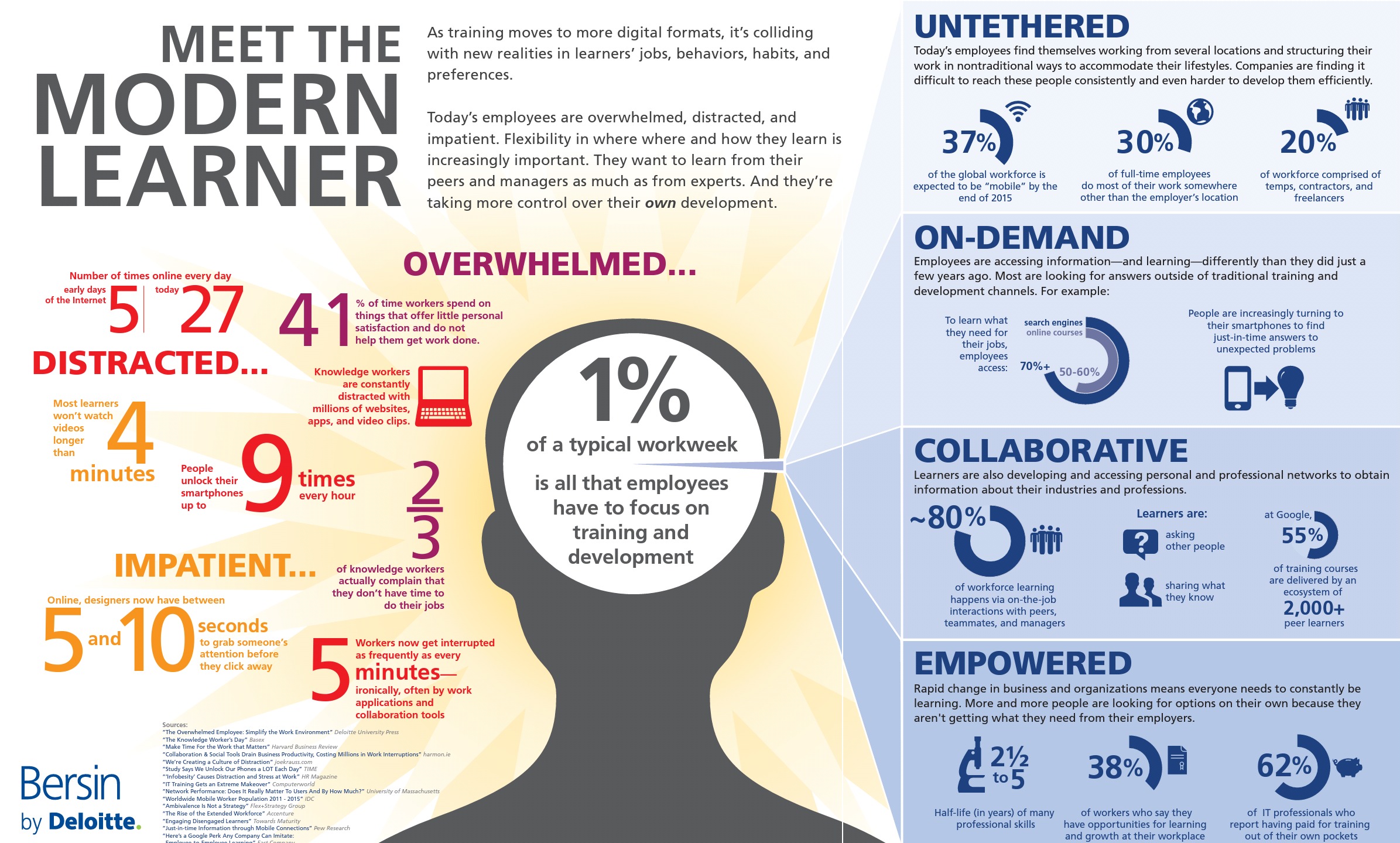When asked how he prefers to learn, an employee replies, “I need to be engaged! Whether the training is delivered in a classroom or over the internet, I’ll retain the information better if the course is interactive. And if I retain the information, I can succeed in my job and make money to support myself.”
Who said it?
(A) Jim, a baby boomer and manager of 15 years
(B) Nicki, a millennial and recent college graduate entering the workforce
The truth is that both employees have the same workforce training preferences and needs. Nicki may be a “digital native,” but like Jim, she prefers learning that involves collaborating with others, practicing real-world skills, and receiving substantive feedback.
We don’t have a millennial learner challenge; we have a modern learner challenge.
“The Modern Learner” Doesn’t Describe Just Millennials
This infographic(1*) illustrates the plight of the modern learner. Employees in every age bracket are overwhelmed by the pace of daily living, distracted by information overload, and impatient to accomplish what needs doing. With only 1% of the workweek available for training, they want interactive learning that’s just in time, microbyte-sized, and immediately actionable.
These factors complicate the path to management, which was formerly paved by earning an MBA. The time and resources needed for the MBA path are out of reach for many, which has given rise to online leadership training events, where retention can be as low as 5%!(2*)
This is where Gillespie Nimble’s “New Manager Jump Series” comes in. This comprehensive new training program caters to the modern learner by pairing heightened engagement with actionable results.
How Gillespie Nimble Engages the Modern Learner
Micro-learning
As workers retire and companies struggle to back-fill positions, modern learners have more demands on their time than ever. The Jump Series courses contain bite-sized modules and activities that take only 5 to 10 minutes each, or less. Timing for each module or activity is clearly listed so that learners can plan their training to fit within their busy days. And the experience is flexible to enable learners to complete as many or as few activities each day as their schedules allow.
Spaced learning
Modern learners require continuous application of skills to create reinforcement, build confidence, and assess how they can move forward. Learners are immersed in each topic for 30 days. Learning activities are spread throughout that time to provide constant reinforcement and time to practice and reflect on new skills. Once the bulk of the learning activities are complete, learners will receive Nibbles twice per week. Nibbles are bite-sized problem scenarios solved individually or in groups to extend the learning and practice the skills acquired.
Cohort-based virtual classes
The modern learner likes to share experiences with others, values the opinions of colleagues, and prefers multiple channels to engage with the information. With Gillespie Nimble, learners are part of a cohort with 10–20 participants. They progress through the program together, learning from each other’s knowledge and background for a richer experience.
Online coaching
Modern learners value personalized information to help them make the best decisions. Each Gillespie Nimble program has a facilitator. This person provides individualized attention, feedback, and encouragement to every learner in the cohort. Customized scenarios enable new managers to effectively transition into leadership roles with a combination of resources and individual support.
To get the complete Seven Ways Gillespie Nimble Engages Learners, download our tip sheet!
To join the next cohort in New Manager Jump Series, enroll now!
For more information on the New Manager Jump Series program, visit gillespienimble.com or contact Michelle Wescott at Michelle@gillespienimble.com or call 585-287-8192.
*Footnotes:
1 Bersin by Deloitte (2014).Meet the Modern Learner (Infographic). Retrieved January 6, 2017 from https://www.bersin.com/Practice/Detail.aspx?id=18071
2 Burge, Joan. (March 25, 2015). Your Case for Training: Adult Learning Retention Statistics. Retrieved January 6, 2017, from http://officedynamics.com/your-case-for-training-adult-learning-retention-statistics/?hvid=3riNcP

